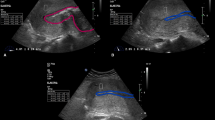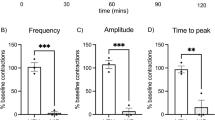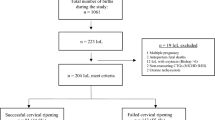Abstract
Objective
It is well established that the duration of the first and second stages of labor are shorter in parous women than in their nulliparous counterparts, a phenomenon not well understood. The aim was to examine the effect of maternal parity on contractile parameters of human myometrium.
Design
Myometrial strips were excised from n = 74 women at cesarean delivery and recordings of contractile activity analyzed and compared across three clinical groups: 1. No previous delivery (P0); 2. One previous delivery (P1); 3. Greater than one previous delivery (P>1).
Results
There was a trend towards greater mean contractile force in the P>1 group than the P1 and P0 groups (P = 0.412). Frequency of contractions was less in the P1 group than in the P0 and P>1 groups(P = 0.027). No differences were observed in relation to all other parameters.
Conclusion
Excluding frequency, no intrinsic differences were observed in the functional parameters of human uterine contractions in relation to parity.
This is a preview of subscription content, access via your institution
Access options
Subscribe to this journal
Receive 12 print issues and online access
$259.00 per year
only $21.58 per issue
Buy this article
- Purchase on Springer Link
- Instant access to full article PDF
Prices may be subject to local taxes which are calculated during checkout


Similar content being viewed by others
References
National Institute for Health and Care Excellence. Intrapartum care: care of healthy women and their babies during childbirth (clinical guideline 190), 2014. www.nice.org.uk/guidance/cg190.
Lavender T, Alfirevic Z, Walkinshaw S. Effect of different partogram lines on birth outcomes: a randomized controlled trial. Obstet Gynecol. 2006;357:295–302.
Kenyon S, Sanders J, Middleton L, Johnston T. What is the best treatment to reduce the need for caesarean section in nulliparous women at term with delayed first stage of labor? BMJ. 2017;357:j2469.
Sharma V, Colleran G, Dineen B, Hession MB, Avalos G, Morrison JJ. Factors influencing delivery mode for nulliparous women with a singleton gestation and cephalic presentation during a 17-year period. Eur J Obstet Gynecol Reprod Biol. 2009;147:173–7.
Cohen WR, Friedman FA. The assessment of labor: a brief history. J Perinat Med. 2018;46:1–8.
Cohen WR. Clinical assessment of uterine contractions. Int J Gynecol Obstet. 2017;139:137–42.
Wray S. Insights from physiology into myometrial function and dysfunction. Exp Physiol. 2015;100:1468–72.
Crankshaw DJ, Morrison JJ. Methodology and pharmacological effects of uterotonic compounds in human myometrium in vitro. Am J Obstet Gynecol. 2011;205:155E1–6.
Crankshaw DJ, O’Brien YM, Crosby DA, Morrison JJ. Maternal age and contractility of human myometrium in pregnancy. Reprod Sci. 2015;22:1229–35.
Crankshaw DJ, O’Brien YM, Crosby DA, Morrison JJ. Maternal body mass index and spontaneous contractility of human myometrium in pregnancy. J Perinatol. 2017;35:492–7.
Ryan GA, Nicholson SM, Crankshaw DJ, Morrison JJ. Human uterine contractility at term in relation to parity. Am J Obstet Gynecol. 2018;218:236. https://doi.org/10.1016/j.ajog.2017.10.319
O’Sullivan MD, Hehir MP, O’Brien YM, Morrison JJ. 17 alpha-hydroxyprogesterone caproate vehicle, castor oil, enhances the contractile effect of oxytocin in human myometrium in pregnancy. Am J Obstet Gynecol. 2010;202:453.e1–4.
Moynihan AT, Hehir MP, Sharkey AM, Robson SC, Europe-Finner GN, Morrison JJ. Histone deacetylase inhibitors and a functional potent inhibitory effect on human uterine contractility. Am J Obstet Gynecol. 2008;199:167.e1–7.
Crankshaw DJ, Walsh JM, Morrison JJ. The effects of methyl palmitate, a putative regulator from perivascular fat, on the contractility of pregnant human myometrium. Life Sci. 2014;116:25–30.
Abalos E, Oladapo OT, Chamillard M, Díaz V, Pasquale J, Bonet M, et al. Duration of spontaneous labour in ‘low-risk’ women with ‘normal’ perinatal outcomes: a systematic review. Eur J Obstet Gynecol Reprod Biol. 2018;223:123–32.
Waldenström U, Ekéus C. Risk of labor dystocia increases with maternal age irrespective of parity: a population-based register study. Acta Obstet Gynecol Scand. 2017;96:1063–9.
Sandström A, Cnattingius S, Wikström AK, Stephansson O. Labour dystocia—risk of recurrence and instrumental delivery in following labour—a population-based cohort study. BJOG. 2012;119:1648–56.
Quenby S, Matthew A, Zhang J, Dawood F, Wray S. In vitro myometrial contractility reflects indication for caesarean section. BJOG. 2011;118:1499–506.
Heuser CC, Knight S, Esplin MS, Eller AG, Holmgren CM, Manuck TA, et al. Tachysystole in term labor: incidence, risk factors, outcomes, and effect on fetal heart tracings. Am J Obstet Gynecol. 2013;209:32.e1–6.
Ahmed AI, Zhu L, Aldhaheri S, Sakr S, Minkoff H, Haberman S. Uterine tachysystole in spontaneous labor at term. J Matern Fetal Neonatal Med. 2016;29:3335–9.
Acknowledgements
This study was carried out in the Lambe Institute for Translational Research, National University of Ireland, Galway.
Funding
National University of Ireland Galway Perinatal Fund.
Author contributions
JJM and DJC conceived and designed the study. All authors were involved in data analysis, writing, and revising the manuscript and all authors have approved the final manuscript submitted. GAR, as the corresponding author, confirms that she has full access to the study data and full permission of all authors to submit for publication.
Author information
Authors and Affiliations
Corresponding author
Ethics declarations
Conflict of interest
The authors declare that they have no conflict of interest.
Additional information
Publisher’s note: Springer Nature remains neutral with regard to jurisdictional claims in published maps and institutional affiliations.
Rights and permissions
About this article
Cite this article
Ryan, G.A., Nicholson, S.M., Crankshaw, D.J. et al. Maternal parity and functional contractility of human myometrium in vitro in the third trimester of pregnancy. J Perinatol 39, 439–444 (2019). https://doi.org/10.1038/s41372-019-0312-2
Received:
Revised:
Accepted:
Published:
Issue Date:
DOI: https://doi.org/10.1038/s41372-019-0312-2
This article is cited by
-
Forces Involved with Labor and Delivery—A Biomechanical Perspective
Annals of Biomedical Engineering (2021)



